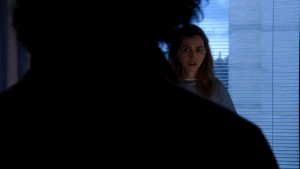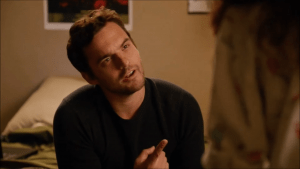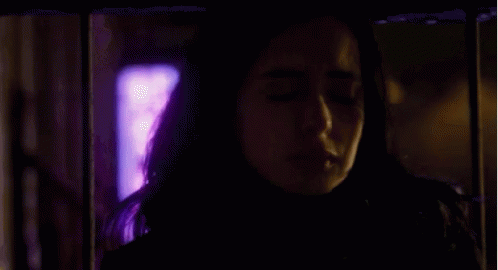I had to switch from reviewing Killjoys to reviewing Sense8 due to difficulties streaming Killjoys.
Sense8 starts off at the end of a dramatic and violent story which, if it had been told, would explain the situation the main characters find themselves abruptly dropped into. As it is, the audience has only slightly more information than the 8 strangers who suddenly begin having vivid and fragmented perceptions of a violent suicide and each others’ lives.
This sense of simultaneous information overload and of lacking key information is reflected in the cinematography and direction of the show.
The main characters are often placed in the middle-ground of a set with obstacles in the foreground partially obstructing view of them. This reflects the limited perspectives the audience and the other seven glimpse of the lives of each of the 8.

Omi, one of the 8, is shown in the middle-ground of the shot. The camera pans left such that the man to whom she is speaking passes in front of her in the foreground.
The 8 are experiencing sensual overload. To reflect that, many of the settings in the show are visually crowded; featuring many vibrant colors.

Will, another of the 8, is in a drugstore. The background is completely full of vibrantly colored products.
Until the beginning of the show, each of the 8 had been living separate lives, each full of unique family and friends. To portray this, many scenes feature a large number of side characters or extras, including at one point an entire pride parade.

This entire pre-wedding celebration, which features at least 6 unique side characters and a backup dancer crew, is all backstory for a single main character.
True to its focus on vivid sensations, the show features multiple explicit sex scenes (which I will not include an example screenshot of). These contribute to the sense that each of the 8 had separate lives before they became inexplicably connected (and also necessarily involve additional side characters).
Despite having many vibrant colors, the show has a very dark lighting and color scheme. All three scenes above are shot at night, the rave lights at the celebration shown are kept to a minimum to maintain low lighting, and scenes are often so dark at first that it is difficult to make out details until more light is (for various reasons) shed on the subject of the scene. This contributes to the theme of incomplete information, as well as giving a somber mood to the show.
The show is comprised of a series of short cuts strung together, rather than longer continuous scenes. This is partly necessitated by the fact that there are 8 main characters who are experiencing things simultaneously in completely different countries. However, even when a scene lasts for a significant length of time and takes place in a single location, that scene is broken up into multiple short cuts from different angles. This gives the story a fragmented and disjointed feeling, as if it is being pieced together rather than unfolding linearly.







